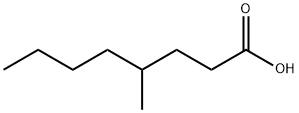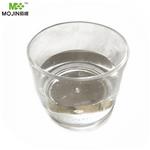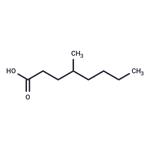4-Methyloctanoic acid, also known as Hircinoic Acid, presents as a colorless to pale-yellow oil. It is slightly soluble in chloroform, DMSO and ethyl acetate. Store in a tightly closed container in a dry and well-ventilated place. Containers which are opened must be carefully resealed and kept upright to prevent leakage. This substance is stable under recommended storage conditions. 4-Methyloctanoic Acid is incompatible with strong oxidizing agents as well as strong bases. This chemical causes severe skin burns and eye damage.
4-Methyloctanoic acid has a fatty, musty, plastic odor. This compound is also reported to have a goat, costus, mutton
odor
4-Methyloctanoic acid is one of the acids mainly responsible for the so-called "soo" odour of mutton. The analogue 4-Ethyloctanoic acid (found in Virginia tobacco and Costus root oil) also has a related goaty odor; this analog has the lowest threshold of all the fatty acids at 1.8 ppb. 4-Methyloctanoic acid is used in flavours for cheese, meat, tobacco and (possibly) fish. Normal use levels in finished consumer product: up to 3 ppm.
Reported found in cooked mutton fat, raw and cooked mutton, lamb, and blue, cheddar, parmesan, provolone
and romano cheeses
Hircinoic Acid, can be used as flavors and fragrance additive. It is also a building block use din sythesis of various chemical compounds such as, rac-Mono-(4-methyloctanyl)-phthalate (M566530).
ChEBI: 4-methyl-octanoic acid is a medium-chain fatty acid.
Aroma characteristics at 1.0% in PG: waxy, fatty, meaty, reheated beef-like with a slightly lactonic cheesy
nuance
Taste characteristics at 10 ppm: fatty, waxy, creamy and lactonic with a satiating fatty mouthfeel and metal�lic nuances.
4-Methyloctanoic acid is a branched fatty acid commonly used in the flavor and fragrance industries. This compound gives sweaty and goaty flavors to the mutton meat and goat′s milk cheese, respectively.



